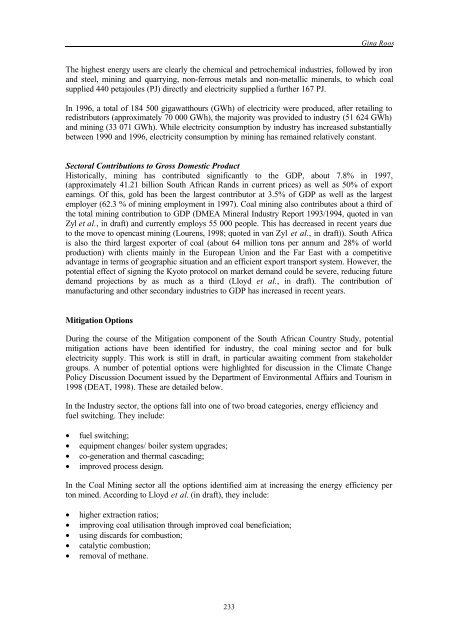sectoral economic costs and benefits of ghg mitigation - IPCC
sectoral economic costs and benefits of ghg mitigation - IPCC
sectoral economic costs and benefits of ghg mitigation - IPCC
You also want an ePaper? Increase the reach of your titles
YUMPU automatically turns print PDFs into web optimized ePapers that Google loves.
Gina Roos<br />
The highest energy users are clearly the chemical <strong>and</strong> petrochemical industries, followed by iron<br />
<strong>and</strong> steel, mining <strong>and</strong> quarrying, non-ferrous metals <strong>and</strong> non-metallic minerals, to which coal<br />
supplied 440 petajoules (PJ) directly <strong>and</strong> electricity supplied a further 167 PJ.<br />
In 1996, a total <strong>of</strong> 184 500 gigawatthours (GWh) <strong>of</strong> electricity were produced, after retailing to<br />
redistributors (approximately 70 000 GWh), the majority was provided to industry (51 624 GWh)<br />
<strong>and</strong> mining (33 071 GWh). While electricity consumption by industry has increased substantially<br />
between 1990 <strong>and</strong> 1996, electricity consumption by mining has remained relatively constant.<br />
Sectoral Contributions to Gross Domestic Product<br />
Historically, mining has contributed significantly to the GDP, about 7.8% in 1997,<br />
(approximately 41.21 billion South African R<strong>and</strong>s in current prices) as well as 50% <strong>of</strong> export<br />
earnings. Of this, gold has been the largest contributor at 3.5% <strong>of</strong> GDP as well as the largest<br />
employer (62.3 % <strong>of</strong> mining employment in 1997). Coal mining also contributes about a third <strong>of</strong><br />
the total mining contribution to GDP (DMEA Mineral Industry Report 1993/1994, quoted in van<br />
Zyl et al., in draft) <strong>and</strong> currently employs 55 000 people. This has decreased in recent years due<br />
to the move to opencast mining (Lourens, 1998; quoted in van Zyl et al., in draft)). South Africa<br />
is also the third largest exporter <strong>of</strong> coal (about 64 million tons per annum <strong>and</strong> 28% <strong>of</strong> world<br />
production) with clients mainly in the European Union <strong>and</strong> the Far East with a competitive<br />
advantage in terms <strong>of</strong> geographic situation <strong>and</strong> an efficient export transport system. However, the<br />
potential effect <strong>of</strong> signing the Kyoto protocol on market dem<strong>and</strong> could be severe, reducing future<br />
dem<strong>and</strong> projections by as much as a third (Lloyd et al., in draft). The contribution <strong>of</strong><br />
manufacturing <strong>and</strong> other secondary industries to GDP has increased in recent years.<br />
Mitigation Options<br />
During the course <strong>of</strong> the Mitigation component <strong>of</strong> the South African Country Study, potential<br />
<strong>mitigation</strong> actions have been identified for industry, the coal mining sector <strong>and</strong> for bulk<br />
electricity supply. This work is still in draft, in particular awaiting comment from stakeholder<br />
groups. A number <strong>of</strong> potential options were highlighted for discussion in the Climate Change<br />
Policy Discussion Document issued by the Department <strong>of</strong> Environmental Affairs <strong>and</strong> Tourism in<br />
1998 (DEAT, 1998). These are detailed below.<br />
In the Industry sector, the options fall into one <strong>of</strong> two broad categories, energy efficiency <strong>and</strong><br />
fuel switching. They include:<br />
• fuel switching;<br />
• equipment changes/ boiler system upgrades;<br />
• co-generation <strong>and</strong> thermal cascading;<br />
• improved process design.<br />
In the Coal Mining sector all the options identified aim at increasing the energy efficiency per<br />
ton mined. According to Lloyd et al. (in draft), they include:<br />
• higher extraction ratios;<br />
• improving coal utilisation through improved coal beneficiation;<br />
• using discards for combustion;<br />
• catalytic combustion;<br />
• removal <strong>of</strong> methane.<br />
233
















